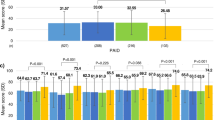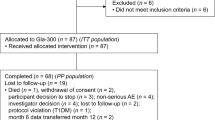Abstract
Purpose
The purpose of the present study was to compare the basic glycemic control parameters—HbA1c, CV%, and hypoglycemia, as well as quality of life and depression score in patients with type 1 diabetes using continuous subcutaneous insulin infusion (CSII) versus multiple daily injections (MDI).
Methods
324 adult patients with type 1 diabetes—146 using CSII and 178 on MDI, were enrolled in this cross-sectional study. HbA1c was assessed in whole blood by immuno-turbidimetric NGSP certified method. CV% was derived from CGM or was calculated from a 9-point capillary blood glucose profile. Hypoglycemia frequency, severity, and awareness were assessed using Clarke’s hypoglycemia questionnaire. Quality of life (QOL) was assessed using a questionnaire by the Psychiatric Research Unit and the CES-D scale.
Results
CSII group compared to MDI group showed significantly lower HbA1c—7.3% (6.6–8.0%) vs 8.2% (7.2–9.6%) (p < 0.0001), lower CV 27.2% (±9.8) vs 34.7% (±11.3) (p < 0.0001), fewer hypoglycemia episodes (p < 0.0001). There was no significant difference in the frequency of severe hypoglycemia, hypoglycemia awareness, QOL, and depression scores between the two groups.
Conclusions
CSII in type 1 diabetes is related to better and more stable glycemic control compared to MDI.
Similar content being viewed by others
Data availability
The datasets generated during and/or analyzed during the current study are available from the corresponding author on reasonable request.
References
R.P. Radermecker, A.J. Scheen,, Continuous subcutaneous insulin infusion with short-acting insulin analogues or human regular insulin: efficacy, safety, quality of life, and cost-effectiveness. Diabetes Metab. Res. Rev. 20(3), 178–188 (2004). https://doi.org/10.1002/dmrr.447.
National Institute for Health and Care Excellence. Diabetes in pregnancy: management from preconception to the postnatal period. https://www.nice.org.uk/guidance/ng3/chapter/Recommendations (2015). Accessed 01 July 2021.
U. Mantaj, P. Gutaj, K. Ozegowska, A. Zawiejska, K. Wroblewska-Seniuk, D. Olejniczak, E. Wender-Ozegowska, Continuous subcutaneous insulin infusion reduces neonatal risk in pregnant women with type 1 diabetes mellitus. Ginekol Pol. 90(3), 154–160 (2019). https://doi.org/10.5603/GP.2019.0028.
M.A. Martínez-Brocca, Benefits of continuous subcutaneous insulin infusion in type 1 diabetes. Is there any doubt? Endocrinol Nutr. 63(3), 103–105 (2016). https://doi.org/10.1016/j.endonu.2015.11.006.
J.C. Pickup, A.J. Sutton, Severe hypoglycaemia and glycaemic control in Type 1 diabetes: meta-analysis of multiple daily insulin injections compared with continuous subcutaneous insulin infusion. Diabet. Med. 25(7), 765–774 (2008). https://doi.org/10.1111/j.1464-5491.2008.02486.x.
J. Pickup, M. Mattock, S. Kerry, Glycaemic control with continuous subcutaneous insulin infusion compared with intensive insulin injections in patients with type 1 diabetes: meta-analysis of randomised controlled trials. BMJ 324(7339), 705 (2002). https://doi.org/10.1136/bmj.324.7339.705.
J.C. Summers, E.M. Briganti, Z.A. Fitzgerald, L.N.J. Lambers, N.D. Cohen, Long-Term Effectiveness of Continuous Subcutaneous Insulin Infusion in the Prevention of Hypoglycemia in Adults with Type 1 Diabetes. Diabetes Technol. Ther. 21(8), 423–429 (2019). https://doi.org/10.1089/dia.2019.0108.
P. Beato-Víbora, E. Yeoh, H. Rogers, D. Hopkins, S.A. Amiel, P. Choudhary, Sustained benefit of continuous subcutaneous insulin infusion on glycaemic control and hypoglycaemia in adults with Type 1 diabetes. Diabet. Med. 32(11), 1453–1459 (2015). https://doi.org/10.1111/dme.12869.
S.M. Blackman, D. Raghinaru, S. Adi et al. Insulin pump use in young children in the T1D Exchange clinic registry is associated with lower hemoglobin A1c levels than injection therapy. Pediatr. Diabetes 15(8), 564–572 (2014). https://doi.org/10.1111/pedi.12121.
J. Olsovský, M. Beránek, The influence of long-term therapy with the insulin pump (CSII) in patients with type 1 diabetes mellitus on metabolic compensation and on the incidence of hypoglycaemia. Comparison with intensified conventional insulin therapy (MDI). Vnitr. Lek. 53(6), 637–645 (2007). PMID: 17702123.
M.I. Maiorino, G. Bellastella, O. Casciano et al. The Effects of Subcutaneous Insulin Infusion Versus Multiple Insulin Injections on Glucose Variability in Young Adults with Type 1 Diabetes: The 2-Year Follow-Up of the Observational METRO Study. Diabetes Technol. Ther. 20(2), 117–126 (2018). https://doi.org/10.1089/dia.2017.0334.
B. Simon, V. Treat, C. Marco et al. A comparison of glycaemic variability in CSII vs. MDI treated type 1 diabetic patients using CGMS. Int. J. Clin. Pract. 62(12), 1858–1863 (2008). https://doi.org/10.1111/j.1742-1241.2008.01932.x.
R. Linkeschova, M. Raoul, U. Bott, M. Berger, M. Spraul, Less severe hypoglycaemia, better metabolic control, and improved quality of life in Type 1 diabetes mellitus with continuous subcutaneous insulin infusion (CSII) therapy; an observational study of 100 consecutive patients followed for a mean of 2 years. Diabet. Med. 19(9), 746–751 (2002). https://doi.org/10.1046/j.1464-5491.2002.00713.x.
M. Lozano-Serrano, J.A. García-Seco, F. García-Seco et al. Satisfaction and quality of life evaluation in patients with type 1 diabetes mellitus treated using continuous subcutaneous insulin infusion compared with multiple daily injections. Enferm. Clin. 23(3), 96–102 (2013). https://doi.org/10.1016/j.enfcli.2013.02.004.
American Diabetes Association Workgroup on Hypoglycemia, Defining and Reporting Hypoglycemia in Diabetes. Diabetes Care 28(5), 1245–1249 (2005). https://doi.org/10.2337/diacare.28.5.1245.
NICE. Type 1 diabetes in adults: diagnosis and management. https://www.nice.org.uk/guidance/ng17/chapter/Recommendations#hypoglycaemia-awareness-and-management (2015). Accessed 01 July 2021.
L.S. Radloff, The CES-D scale: A self report depression scale for research in the general population. Appl. Psychol. Measurements. 1, 385–401. (1977) https://doi.org/10.1177/014662167700100306.
C.W. Topp, S.D. Østergaard, S. Søndergaard, P. Bech, The WHO-5 Well-Being Index: a systematic review of the literature. Psychother Psychosom 84(3), 167–176 (2015). https://doi.org/10.1159/000376585.
Danne T., Nimri R., Battelino T., et al. International Consensus on Use of Continuous Glucose Monitoring. Diabetes Care 40(12), 1631–1640. https://doi.org/10.2337/dc17-1600.
NICE. Continuous subcutaneous insulin infusion for the treatment of diabetes mellitus. https://www.nice.org.uk/guidance/ta151/chapter/1-Guidance (2008). Accessed 1 July 2021.
I. Martín-Timón, F.J. Del Cañizo-Gómez, Mechanisms of hypoglycemia unawareness and implications in diabetic patients. World J Diabetes 6(7), 912–926 (2015). https://doi.org/10.4239/wjd.v6.i7.912.
M. Visser, S. Charleer, S. Fieuws, et al. Comparing real-time and intermittently scanned continuous glucose monitoring in adults with type 1 diabetes (ALERTT1): a 6-month, prospective, multicentre, randomised controlled trial. Lancet. 2021. https://doi.org/10.1016/S0140-6736(21)00789-3.
Acknowledgements
The authors would like to thank the staff of the Division of Diabetology, Department of Endocrinology, Medical University of Sofia, for their assistance.
Author information
Authors and Affiliations
Contributions
All authors contributed to the study conception and design. Material preparation, data collection and analysis were performed by P.T., N.C., R.D., A.T., M.Se., and M.Sa. P.T., R.D., and N.C. were responsible for statistical analysis, data interpretation and drafting of the manuscript. T.T. performed critical revision of the manuscript.
Corresponding author
Ethics declarations
Conflict of interest
The authors declare no competing interests.
Ethics approval
All participants signed informed consent for participation in the study in accordance with the Helsinki Declaration and rules of Good Clinical Practice, as the study was approved by the Ethics Committee of the Medical University of Sofia.
Consent to participate
Informed consent was obtained from all individual participants included in the study.
Consent for publication
Patients signed informed consent regarding publishing their data.
Additional information
Publisher’s note Springer Nature remains neutral with regard to jurisdictional claims in published maps and institutional affiliations.
Rights and permissions
About this article
Cite this article
Tsarkova, P., Chakarova, N., Dimova, R. et al. CSII is related to more stable glycemia in adults with type 1 diabetes. Endocrine 75, 776–780 (2022). https://doi.org/10.1007/s12020-021-02913-9
Received:
Accepted:
Published:
Issue Date:
DOI: https://doi.org/10.1007/s12020-021-02913-9




